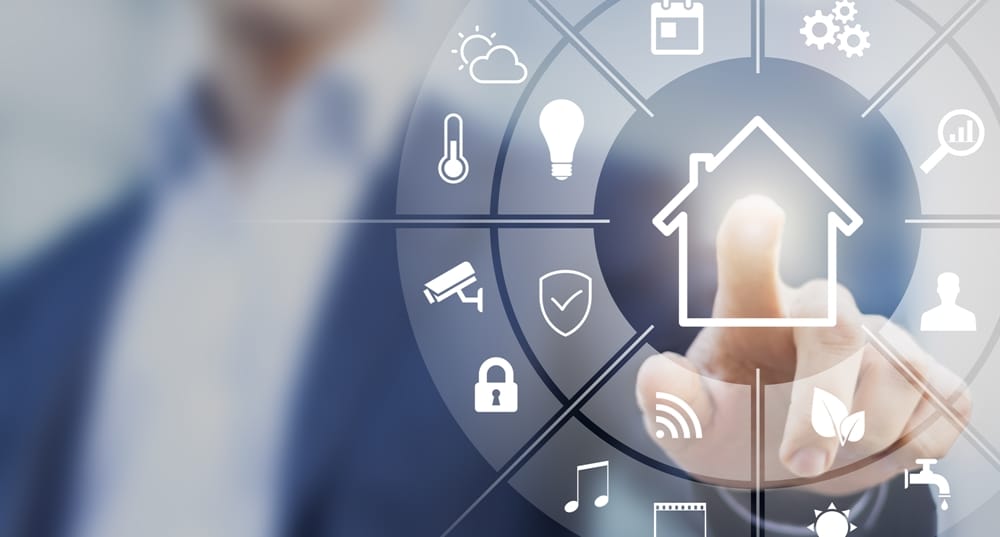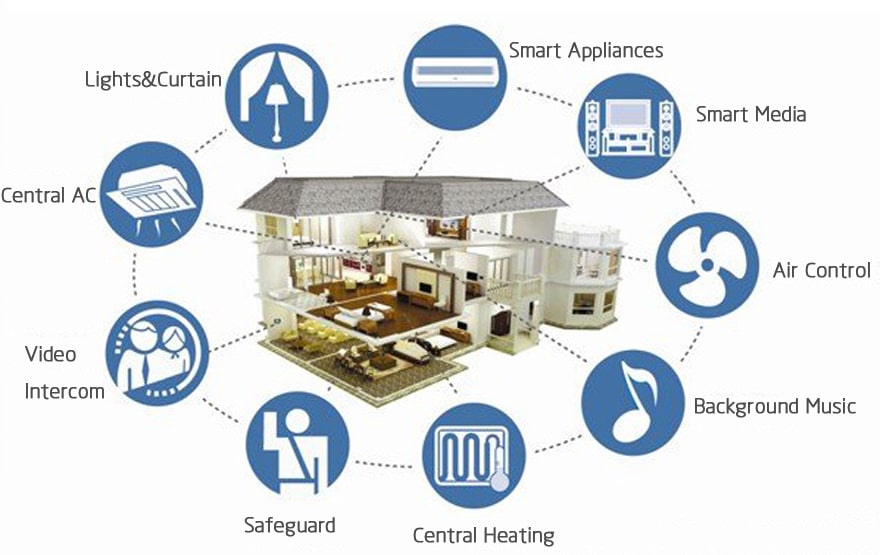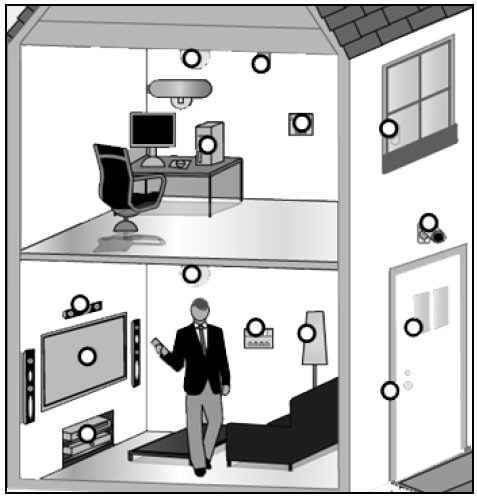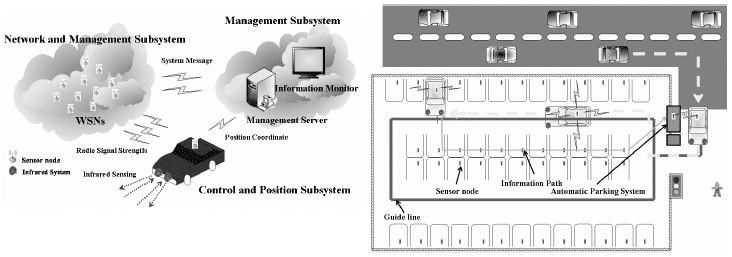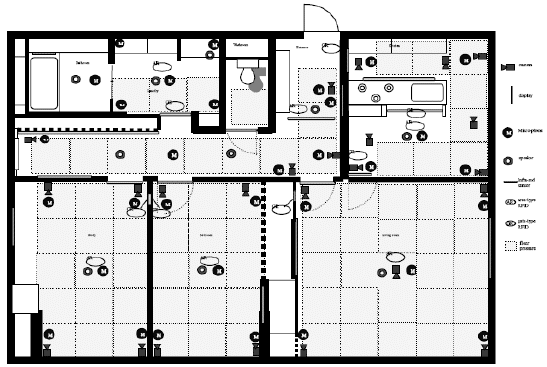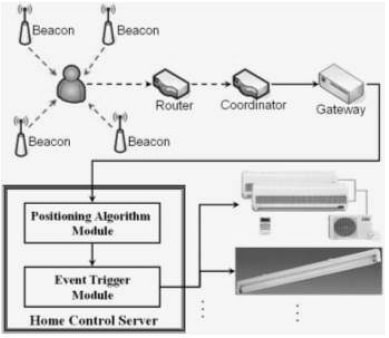Abstract
Smart Home technology started for more than a decade to introduce the concept of networking devices and equipment in the house. According to the Smart Homes Association the best definition of smart home technology is: the integration of technology and services through home networking for a better quality of living. Many tools that are used in computer systems can also be integrated in Smart Home Systems. In this paper, we present the Technologies and tools that can be integrated or applied in Smart Home systems.
1. Introduction
Advancements in the field of smart homes are not an isolated case. First of all the developments take place within the society and are influenced by trends within that society. Furthermore in order to create added value the focus should be on the smart home environment instead of only on the used technology. Thirdly creating smart environments to support elderly and disabled persons has enormous potential. To live up fully to the expectations is however a complex process which involves various stakeholders. Smart Home is the integration of technology and services through home networking for a better quality of living. A lot technologies related to Smart Home are emerging. In the next sections, we define Smart Home, Related Technologies and Trends.
2. Smart Home Systems
Smart Home is the term commonly used to define a residence that uses a Home Controller to integrate the residence’s various home automation systems. The most popular Home Controllers are those that are connected to a Windows based PC during programming only, and are then left to perform the home control duties on a standalone basis. Integrating the home systems allows them to communicate with one another through the home controller, thereby enabling single button and voice control of the various home systems simultaneously, in preprogrammed scenarios or operating modes.
The Home Automation field is expanding rapidly as electronic technologies converge. The home network encompasses communications, entertainment, security, convenience, and information systems. [2] Powerline Carrier Systems (PCS) is a technology which is used to send coded signals along a home’s existing electric wiring to programmable switches, or outlets. These signals convey commands that correspond to “addresses” or locations of specific devices, and that control how and when those devices operate. A PCS transmitter, for instance, can send a signal along a home’s wiring, and a receiver plugged into any electric outlet in the home could receive that signal and operate the appliance to which it is attached.
X10 is a common protocol for PCS, it is a signaling technique for remotely controlling any device plugged into an electrical power line. X10 signals, which involve short radio frequency (RF) bursts that represent digital information, enable communication between transmitters and receivers. In Europe, technology to equip homes with smart devices centers on development of the European Installation Bus, or Instabus. This embedded control protocol for digital communication between smart devices consists of a two-wire bus line that is installed along with normal electrical wiring. The Instabus line links all appliances to a decentralized communication system and functions like a telephone line over which appliances can be controlled. The European Installation Bus Association is part of Konnex, an association that aims to standardize home and building networks in Europe.
Figure 1. Smart Home Technology Automation
The creator of the LonWorks system, Echelon Corp., is helping drive adoption of an open interoperability standard among vendors in the control networks industry. LonWorks is an open standard for network automation and control for the building, transportation, industrial and home markets. The American National Standards Institute (ANSI) has adopted the protocol underlying LonWorks control networks as an industry standard. The LonMark Interoperability Association is made up of more than 200 controls companies’ mission working on standard to integrate multi-vendor systems based on LonWorks networks.
2.1. Smart Home Technology
All the appliances and devices are receivers, and the means of controlling the system, such as remote controls or keypads, are transmitters. If you want to turn off a lamp in another room, the transmitter will issue a message in numerical code that includes the following:
An alert to the system that it’s issuing a command,
An identifying unit number for the device that should receive the command and
A code that contains the actual command, such as “turn off.”
All of this is designed to happen in less than a second, but X10 does have some limitations.
Communicating over electrical lines is not always reliable because the lines get “noisy” from powering other devices. An X10 device could interpret electronic interference as a command and react, or it might not receive the command at all. While X10 devices are still around, other technologies have emerged to compete for your home networking dollar.Instead of going through the power lines, some systems use radio waves to communicate, which is also how WiFi and cell phone signals operate. However, home automation networks don’t need all the juice of a WiFi network because automation commands are short messages. The two most prominent radio networks in home automation are ZigBee and Z-Wave. Both of these technologies are mesh networks, meaning there’s more than one way for the message to get to its destination.
Figure 2. The dots represent devices that could be connected to your smart home network.
2.1.1 Z-Wave
Z-Wave uses a Source Routing Algorithm to determine the fastest route for messages. Each Z-Wave device is embedded with a code, and when the device is plugged into the system, the network controller recognizes the code, determines its location and adds it to the network. When a command comes through, the controller uses the algorithm to determine how the message should be sent. Because this routing can take up a lot of memory on a network, Z-Wave has developed a hierarchy between devices: Some controllers initiate messages, and some are “slaves,” which means they can only carry and respond to messages.
2.1.2 ZigBee
ZigBee’s name illustrates the mesh networking concept because messages from the transmitter zigzag like bees, looking for the best path to the receiver. While Z-Wave uses a proprietary technology for operating its system, ZigBee’s platform is based on the standard set by the Institute for Electrical and Electronics Engineers (IEEE) for wireless personal networks. This means any company can build a ZigBee compatible product without paying licensing fees for the technology behind it, which may eventually give ZigBee an advantage in the marketplace. Like Z-Wave, ZigBee has fully functional devices (or those that route the message) and reduced function devices (or those that don’t).
2.1.3 Insteon.
Using a wireless network provides more flexibility for placing devices, but like electrical lines, they might have interference. Insteon offers a way for your home network to communicate over both electrical wires and radio waves, making it a dual mesh network. If the message isn’t getting through on one platform, it will try the other. Instead of routing the message, an Insteon device will broadcast the message, and all devices pick up the message and broadcast it until the command is performed. The devices act like peers, as opposed to one serving as an instigator and another as a receptor. This means that the more Insteon devices that are installed on a network, the stronger the message will be.
2.2. Installing a Smart Home
Z-Wave, X10, Insteon and ZigBee just provide the technology for smart home communication. Manufacturers have made alliances with these systems to create the products that use the technology. Here are some examples of smart home products and their functions.
Cameras will track your home’s exterior even if it’s pitch-black outside.
Plug your tabletop lamp into a dimmer instead of the wall socket, and you can brighten and dim at the push of a button.
A video door phone provides more than a doorbell — you get a picture of who’s at the door.
Motion sensors will send an alert when there’s motion around your house, and they can even tell the difference between pets and burglars.
Door handles can open with scanned fingerprints or a four-digit code, eliminating the need to fumble for house keys.
Audio systems distribute the music from your stereo to any room with connected speakers.
Channel modulators take any video signal — from a security camera to your favorite television station — and make it viewable on every television in the house.
Remote controls, keypads and tabletop controllers are the means of activating the smart home applications. Devices also come with built-in web servers that allow you to access their information online.
The Remote keypad will send a message to your lamp. These products are available at home improvement stores, electronics stores, from technicians or o-nline. Before buying, check to see what technology is associated with the product. Products using the same technology should work together despite different manufacturers, but joining up an X10 and a Z-Wave product requires a bridging device.
When designing a smart home, you can do as much or as little home automation as you want. You could begin with a lighting starter kit and add on security devices later. If you want to start with a bigger system, it’s a good idea to design carefully how the home will work, particularly if rewiring or renovation will be required. In addition, you’ll want to place strategically the nodes of the wireless networks so that they have a good routing range. The cost of a smart home varies depending on how smart the home is. One builder estimates that his clients spend between $10,000 and $250,000 for sophisticated systems. If you build the smart home gradually, starting with a basic lighting system, it might only be a few hundred dollars. A more sophisticated system will be tens of thousands of dollars, and elements of home theater systems raise the cost of a system about 50 percent.
2.3. Smart Home Advantages
Smart homes obviously have the ability to make life easier and more convenient. Home networking can also provide peace of mind. Whether you’re at work or on vacation, the smart home will alert you to what’s going on, and security systems can be built to provide an immense amount of help in an emergency. For example, not only would a resident be woken with notification of a fire alarm, the smart home would also unlock doors, dial the fire department and light the path to safety.
Smart homes also provide some energy efficiency savings. Because systems like Z-Wave and ZigBee put some devices at a reduced level of functionality, they can go to “sleep” and wake up when commands are given. Electric bills go down when lights are automatically turned off when a person leaves the room, and rooms can be heated or cooled based on who’s there at any given moment. One smart homeowner boasted her heating bill was about onethird less than a same-sized normal home. Some devices can track how much energy each appliance is using and command it to use less.
Smart home technology promises tremendous benefits for an elderly person living alone. Smart homes could notify the resident when it was time to take medicine, alert the hospital if the resident fell and track how much the resident was eating. If the elderly person was a little forgetful, the smart home would perform tasks such as shutting off the water before a tub overflowed or turning off the oven if the cook had wandered away. It also allows adult children who might live elsewhere to participate in the care of their aging parent. Easy-tocontrol automated systems would provide similar benefits to those with disabilities or a limited range of movement.
3. Smart Home Devices
The prevalence of smart home appliances, which can be programmed to do nearly anything, is such that consumers purchase and use them without a second thought. Currently, there are virtually no appliances in the home that are not available with some degree of automation.
The combination of automation and programmability with artificial intelligence is the next step in the evolution of the home automation system.
3.1. Home Automation Systems
Instead of being forced to move into a nursing home when unable to achieve full self-care, elderly individuals can rely on their smart home appliances. An intelligent interface that monitors the residents’ movements, and learns to recognize their habits, can notify loved ones if the habits are interrupted. In addition, a smart home has the capability of monitoring the vital signs of residents. If an elderly person has a medical condition that could be of concern, the vital signs can be routinely sent to the appropriate medical facility. The smart home equipped with artificial intelligence will learn to distinguish dangerous readings, and alert medical personnel immediately.
3.2. Smart Home Appliances for Physically Challenged Individuals
If an individual has difficulty moving around effectively, they are often forced to depend on others for care. With the implementation of smart home appliances, such as an effective security system, those with physical challenges are often able to live on their own. A smart home security system allows the homeowner to remotely view visitors on a camera, and speak to them via microphone and speakers. If the visitor is welcome, the security system unlocks and opens the door to allow the visitor access to the home. Smart home security systems can also learn which visitors are always allowed, and what areas they may have access to. [5]
4. Smart Home Technology Trends
Many smart home devices provide home automation technology, nowadays many tools that are used in computer systems can also be integrated in Smart Home Systems. In this section, we review the tools and technology trends related to Smart Home.
4.1. Automatic Vehicle Parking System
The Parking System works like the following scenario, the vehicle has to be driven to the gate of the parking garage. The driver draws a parking ticket, and then drives the vehicle to search an available parking space for parking. The automatic vehicle parking system has to be designed to be smart and easily managed. Vehicles can search parking space and park themselves in correct spaces automatically.
Figure 3. Architecture and the operation procedure of the automatic vehicle parking system.
The major work of the parking management subsystem is to supply user interface, and to display system status and information. The control and positioning subsystem is embedded on the vehicle, and is able to control the behavior of the mobile vehicle and compute its current position according to the received signals. The WSN network and management subsystem is deployed in the parking garage. It is responsible for monitoring the status of the vehicle, and transmitting commands and data between the parking management subsystem and the control and positioning subsystem.
Sensor nodes are equipped with the parking spaces for the purposes of positioning and communications. A guide line is painted on the road surface. The infrared detector embedded on the vehicle can detect the guide line and report to the control and positioning subsystem.
The vehicle thus can avoid deviation from the guide line, due to the inaccuracy of the position estimated. In the automatic vehicle parking system, the driver just takes a parking ticket and leaves the vehicle on the gate. The parking management system will communicate with the control and positioning subsystem on vehicle, and command the vehicle to move to and park on an assigned available parking space. The WSN management system will keep monitoring the parking space for the reason of security. As long as the driver wants to take back the vehicle, he just pays the parking fees and the vehicle will automatically move to the exit gate.
4.2. The Ubiquitous Home
At the Ubiquitous Home, experimenters can collect real-life data as if living in their own house, not in a laboratory.
Figure 4. The Layout of the Ubiquitous Home
The Ubiquitous Home differs from other test beds in three aspects: first, its enhanced ubiquity of sensors in the Ubiquitous Home; it have many cameras and microphones in each room and various types of sensors to monitor locations in every space of the home. Second, it has remote Japanese-style room, with which we can test remote family connectivity and create a test bed for specific Japanese services. Third, the robots in home service . The robot is called Phyno and has a camera, a microphone and a speaker. Its neck has three degrees of freedom (DOF), its arm does one DOF and its waist does one DOF. Using the camera, Phyno can recognize registered user faces. A decomposed eigenface method is used for the face recognition. The method realizes robust recognition under various lighting conditions.
The Ubiquitous Home has a living room, dining-kitchen, study, bedroom, washroom and bathroom, these rooms comprising an apartment. In addition to the apartment, a Japanesestyle room is provided as a living space for remotely living family members, such as a grandmother and/or a grandfather. Between the apartment and the Japanese-style room is a computer room called the Network Operating Center (NOC).
4.3. Positioning Method for Smart Home Applications
The next figure shows the proposed smart home system architecture. In this system, several devices called the beacons were pre-installed in the interesting area. The mobile users are required to equip with a mobile device called the badge which periodically broadcasts echo requests to collect the positioning signals from the beacons and then forward the positioning signals to a nearby router. The positioning signal of a beacon contains the ID and the signal strength of the beacon.
Figure 5. System Architechture
Whenever a router received the positioning signals from a badge, it forwards the positioning signals to its coordinator directly or through the help of other routers. In Zigbee network, the coordinator is used to coordinate the operation of all the routers in the same network and collect packets from the routers. The packets are then forwarded to the home control server through the gateway which equips with the Zigbee communication module and the Ethernet communication module. The positioning module in the home control server is used to estimate the positions of the badges according to the positioning signals from the badges. The estimate positions of the badges are then forwarded to the event trigger module.
The event trigger module maintains numerous rules which control the household appliances. If the estimate position of a badge satisfies certain rules, the corresponding events will be triggered and some commands will be sent to corresponding household appliances to change their states.
5. Conclusion
People who are elderly or disabled benefit the most from a home automation system that employs artificial intelligence. These systems offer those who are less mobile, or in delicate health, the opportunity to be independent, rather than staying in an assisted living facility. Designing a Smart Home is also very crucial. This can be tough; putting together a home design that reflects your taste, yet also fits your needs and budget is a balancing act that takes planning. The following are ten guidelines to help you on your way: [9]
Do Your Home Design Homework – You must first decide what type of home to build. House styles today are as varied as those who live in them, offering you a banquet of ideas from which to borrow.
Create Your Home Design List – When creating a list of criteria for your home design, start with the basics: the number of bedrooms, the number of bathrooms, the number of family areas, the choice between a formal dining room or a more open, community eating area, porch or deck styles for your home’s entrances and the size of your garage.
Check Local Zoning Laws – Zoning laws can affect everything from house framing to yard fencing.
Design Within Your Budget – Once your list is completed, compare it to your budget and adjust to fit.
Design to Fit Your Plot – Your land is unique; each plot has assets and challenges. Keep these in mind while creating your home design. Use existing grades of your plot to your favor. If your lot slopes sharply to the side, consider a walkout side basement door instead of the traditional back door. Working with your land, instead of against, saves you excavating costs and retains more of your plots natural character.
Maximize Your Space Efficiency – When mapping out your floor plan, make sure there is a logical flow to your home design. You want to simplify life for your contractor while he builds and for your family while they live in it.
Plan for Expansion – If you can’t afford to build your entire dream house now, plan your home design so that expansion is not only possible, but easy. One way of doing so is to build your home in phases.
Picture Interior Design – When putting together your floor plan, place furniture in the design to see how it all fits together. You can do this using graph paper, magazine clippings or by using home design software. Also, consider your lighting scheme, paint and flooring choices, and how your design will work for entertaining–planning for all your favorite activities will help you create proper seating, dining and socializing space.
Don’t Forget the Sun – The position of the sun can affect your home design in many ways, depending on the direction your home faces. A south facing home will be warmer in the winter, but hotter in the summer. Place windows to take advantage of natural light, which allows for better energy conservation.
Beautify All Sides of Your Home Design – Remember that window placement affects the inside and outside look of your house. Whether you live on a corner or in the middle of the block, the sides of your home are going to be seen. Design the look of your home so that you’d be proud to let anyone walk around it, putting small design elements here and there.

